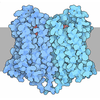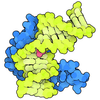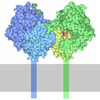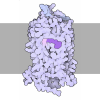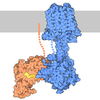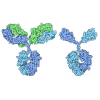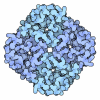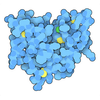[English] 日本語
 Yorodumi
Yorodumi- PDB-8gy7: Cryo-EM structure of ACTH-bound melanocortin-2 receptor in comple... -
+ Open data
Open data
- Basic information
Basic information
| Entry | Database: PDB / ID: 8gy7 | |||||||||||||||||||||||||||||||||||||||||||||
|---|---|---|---|---|---|---|---|---|---|---|---|---|---|---|---|---|---|---|---|---|---|---|---|---|---|---|---|---|---|---|---|---|---|---|---|---|---|---|---|---|---|---|---|---|---|---|
| Title | Cryo-EM structure of ACTH-bound melanocortin-2 receptor in complex with MRAP1 and Gs protein | |||||||||||||||||||||||||||||||||||||||||||||
 Components Components |
| |||||||||||||||||||||||||||||||||||||||||||||
 Keywords Keywords | MEMBRANE PROTEIN / melanocortin-2 receptor / MRAP1 / GPCR / ACTH | |||||||||||||||||||||||||||||||||||||||||||||
| Function / homology |  Function and homology information Function and homology informationcorticotropin hormone receptor binding / type 5 melanocortin receptor binding / corticotropin receptor activity / type 1 melanocortin receptor binding / Defective ACTH causes obesity and POMCD / type 3 melanocortin receptor binding / type 4 melanocortin receptor binding / regulation of corticosterone secretion / adenylate cyclase-activating serotonin receptor signaling pathway / melanocortin receptor activity ...corticotropin hormone receptor binding / type 5 melanocortin receptor binding / corticotropin receptor activity / type 1 melanocortin receptor binding / Defective ACTH causes obesity and POMCD / type 3 melanocortin receptor binding / type 4 melanocortin receptor binding / regulation of corticosterone secretion / adenylate cyclase-activating serotonin receptor signaling pathway / melanocortin receptor activity / signaling receptor regulator activity / sensory perception of chemical stimulus / negative regulation of adenylate cyclase-activating G protein-coupled receptor signaling pathway / mu-type opioid receptor binding / negative regulation of adenylate cyclase activity / corticotropin-releasing hormone receptor 1 binding / GTP metabolic process / beta-2 adrenergic receptor binding / regulation of metabolic process / positive regulation of adenylate cyclase-activating G protein-coupled receptor signaling pathway / regulation of adenylate cyclase-activating G protein-coupled receptor signaling pathway / positive regulation of macroautophagy / PKA activation in glucagon signalling / G protein-coupled receptor signaling pathway, coupled to cyclic nucleotide second messenger / developmental growth / D1 dopamine receptor binding / negative regulation of protein localization to plasma membrane / Hedgehog 'off' state / Adenylate cyclase inhibitory pathway / response to prostaglandin E / insulin-like growth factor receptor binding / adenylate cyclase regulator activity / ionotropic glutamate receptor binding / Peptide ligand-binding receptors / secretory granule / adenylate cyclase activator activity / protein localization to plasma membrane / electron transport chain / G protein-coupled receptor binding / G protein-coupled receptor activity / adenylate cyclase-inhibiting G protein-coupled receptor signaling pathway / hormone activity / bone development / adenylate cyclase-modulating G protein-coupled receptor signaling pathway / platelet aggregation / G-protein beta/gamma-subunit complex binding / centriolar satellite / Olfactory Signaling Pathway / Activation of the phototransduction cascade / G beta:gamma signalling through PLC beta / Presynaptic function of Kainate receptors / Thromboxane signalling through TP receptor / G protein-coupled acetylcholine receptor signaling pathway / adenylate cyclase-activating G protein-coupled receptor signaling pathway / Activation of G protein gated Potassium channels / Inhibition of voltage gated Ca2+ channels via Gbeta/gamma subunits / G-protein activation / Prostacyclin signalling through prostacyclin receptor / G beta:gamma signalling through CDC42 / Glucagon signaling in metabolic regulation / G beta:gamma signalling through BTK / Synthesis, secretion, and inactivation of Glucagon-like Peptide-1 (GLP-1) / ADP signalling through P2Y purinoceptor 12 / photoreceptor disc membrane / Sensory perception of sweet, bitter, and umami (glutamate) taste / Glucagon-type ligand receptors / Adrenaline,noradrenaline inhibits insulin secretion / Vasopressin regulates renal water homeostasis via Aquaporins / GDP binding / Glucagon-like Peptide-1 (GLP1) regulates insulin secretion / G alpha (z) signalling events / cellular response to catecholamine stimulus / ADP signalling through P2Y purinoceptor 1 / ADORA2B mediated anti-inflammatory cytokines production / G beta:gamma signalling through PI3Kgamma / adenylate cyclase-activating dopamine receptor signaling pathway / Cooperation of PDCL (PhLP1) and TRiC/CCT in G-protein beta folding / GPER1 signaling / Inactivation, recovery and regulation of the phototransduction cascade / cellular response to prostaglandin E stimulus / G-protein beta-subunit binding / heterotrimeric G-protein complex / G alpha (12/13) signalling events / sensory perception of taste / extracellular vesicle / signaling receptor complex adaptor activity / Thrombin signalling through proteinase activated receptors (PARs) / positive regulation of cold-induced thermogenesis / retina development in camera-type eye / G protein activity / GTPase binding / Ca2+ pathway / fibroblast proliferation / midbody / High laminar flow shear stress activates signaling by PIEZO1 and PECAM1:CDH5:KDR in endothelial cells / G alpha (i) signalling events / G alpha (s) signalling events / phospholipase C-activating G protein-coupled receptor signaling pathway / G alpha (q) signalling events / Hydrolases; Acting on acid anhydrides; Acting on GTP to facilitate cellular and subcellular movement Similarity search - Function | |||||||||||||||||||||||||||||||||||||||||||||
| Biological species |  Homo sapiens (human) Homo sapiens (human)synthetic construct (others) | |||||||||||||||||||||||||||||||||||||||||||||
| Method | ELECTRON MICROSCOPY / single particle reconstruction / cryo EM / Resolution: 3.3 Å | |||||||||||||||||||||||||||||||||||||||||||||
 Authors Authors | Luo, P. / Feng, W.B. / Ma, S.S. / Dai, A.T. / Yuan, Q.N. / Wu, K. / Yang, D.H. / Wang, M.W. / Xu, H.E. / Jiang, Y. | |||||||||||||||||||||||||||||||||||||||||||||
| Funding support |  China, 1items China, 1items
| |||||||||||||||||||||||||||||||||||||||||||||
 Citation Citation |  Journal: Cell Res / Year: 2023 Journal: Cell Res / Year: 2023Title: Structural basis of signaling regulation of the human melanocortin-2 receptor by MRAP1. Authors: Ping Luo / Wenbo Feng / Shanshan Ma / Antao Dai / Kai Wu / Xianyue Chen / Qingning Yuan / Xiaoqing Cai / Dehua Yang / Ming-Wei Wang / H Eric Xu / Yi Jiang /  Abstract: G protein-coupled receptors (GPCRs) are regulated by various downstream proteins, of which the melanocortin receptor accessory protein 1 (MRAP1) is closely involved in the regulation of melanocortin ...G protein-coupled receptors (GPCRs) are regulated by various downstream proteins, of which the melanocortin receptor accessory protein 1 (MRAP1) is closely involved in the regulation of melanocortin receptor 2 (MC2R). Assisted by MRAP1, MC2R responds to adrenocorticotropic hormone (ACTH) and stimulates glucocorticoid biogenesis and cortisol secretion. MC2R activation plays an essential role in the hypothalamic-pituitary-adrenal (HPA) axis that regulates stress response, while its dysfunction causes glucocorticoid insufficiency- or cortisol excess-associated disorders. Here, we present a cryo-electron microscopy (cryo-EM) structure of the ACTH-bound MC2R-G-MRAP1 complex. Our structure, together with mutagenesis analysis, reveals a unique sharp kink at the extracellular region of MRAP1 and the 'seat-belt' effect of MRAP1 on stabilizing ACTH binding and MC2R activation. Mechanisms of ACTH recognition by MC2R and receptor activation are also demonstrated. These findings deepen our understanding of GPCR regulation by accessory proteins and provide valuable insights into the ab initio design of therapeutic agents targeting MC2R. | |||||||||||||||||||||||||||||||||||||||||||||
| History |
|
- Structure visualization
Structure visualization
| Structure viewer | Molecule:  Molmil Molmil Jmol/JSmol Jmol/JSmol |
|---|
- Downloads & links
Downloads & links
- Download
Download
| PDBx/mmCIF format |  8gy7.cif.gz 8gy7.cif.gz | 219.3 KB | Display |  PDBx/mmCIF format PDBx/mmCIF format |
|---|---|---|---|---|
| PDB format |  pdb8gy7.ent.gz pdb8gy7.ent.gz | 162.2 KB | Display |  PDB format PDB format |
| PDBx/mmJSON format |  8gy7.json.gz 8gy7.json.gz | Tree view |  PDBx/mmJSON format PDBx/mmJSON format | |
| Others |  Other downloads Other downloads |
-Validation report
| Summary document |  8gy7_validation.pdf.gz 8gy7_validation.pdf.gz | 1.1 MB | Display |  wwPDB validaton report wwPDB validaton report |
|---|---|---|---|---|
| Full document |  8gy7_full_validation.pdf.gz 8gy7_full_validation.pdf.gz | 1.1 MB | Display | |
| Data in XML |  8gy7_validation.xml.gz 8gy7_validation.xml.gz | 37.4 KB | Display | |
| Data in CIF |  8gy7_validation.cif.gz 8gy7_validation.cif.gz | 55.2 KB | Display | |
| Arichive directory |  https://data.pdbj.org/pub/pdb/validation_reports/gy/8gy7 https://data.pdbj.org/pub/pdb/validation_reports/gy/8gy7 ftp://data.pdbj.org/pub/pdb/validation_reports/gy/8gy7 ftp://data.pdbj.org/pub/pdb/validation_reports/gy/8gy7 | HTTPS FTP |
-Related structure data
| Related structure data |  34371MC M: map data used to model this data C: citing same article ( |
|---|---|
| Similar structure data | Similarity search - Function & homology  F&H Search F&H Search |
- Links
Links
- Assembly
Assembly
| Deposited unit | 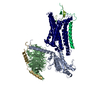
|
|---|---|
| 1 |
|
- Components
Components
-Guanine nucleotide-binding protein ... , 3 types, 3 molecules ABG
| #1: Protein | Mass: 41879.465 Da / Num. of mol.: 1 Source method: isolated from a genetically manipulated source Source: (gene. exp.)  Homo sapiens (human) / Gene: GNAI3, GNAS, GNAS1 / Production host: Homo sapiens (human) / Gene: GNAI3, GNAS, GNAS1 / Production host:  Trichoplusia ni (cabbage looper) / References: UniProt: P08754, UniProt: Q5JWF2 Trichoplusia ni (cabbage looper) / References: UniProt: P08754, UniProt: Q5JWF2 |
|---|---|
| #2: Protein | Mass: 40226.992 Da / Num. of mol.: 1 Source method: isolated from a genetically manipulated source Source: (gene. exp.)  Homo sapiens (human) / Gene: GNB1 / Production host: Homo sapiens (human) / Gene: GNB1 / Production host:  Trichoplusia ni (cabbage looper) / References: UniProt: P62873 Trichoplusia ni (cabbage looper) / References: UniProt: P62873 |
| #3: Protein | Mass: 7861.143 Da / Num. of mol.: 1 Source method: isolated from a genetically manipulated source Source: (gene. exp.)  Homo sapiens (human) / Gene: GNG2 / Production host: Homo sapiens (human) / Gene: GNG2 / Production host:  Trichoplusia ni (cabbage looper) / References: UniProt: P59768 Trichoplusia ni (cabbage looper) / References: UniProt: P59768 |
-Protein , 2 types, 2 molecules PR
| #5: Protein | Mass: 20486.178 Da / Num. of mol.: 1 Source method: isolated from a genetically manipulated source Source: (gene. exp.)  Homo sapiens (human) / Gene: MRAP, C21orf61, FALP / Production host: Homo sapiens (human) / Gene: MRAP, C21orf61, FALP / Production host:  Trichoplusia ni (cabbage looper) / References: UniProt: Q8TCY5 Trichoplusia ni (cabbage looper) / References: UniProt: Q8TCY5 |
|---|---|
| #6: Protein | Mass: 67391.219 Da / Num. of mol.: 1 Source method: isolated from a genetically manipulated source Source: (gene. exp.)  Homo sapiens (human) / Gene: cybC, MC2R, ACTHR / Production host: Homo sapiens (human) / Gene: cybC, MC2R, ACTHR / Production host:  Trichoplusia ni (cabbage looper) / References: UniProt: P0ABE7, UniProt: Q01718 Trichoplusia ni (cabbage looper) / References: UniProt: P0ABE7, UniProt: Q01718 |
-Protein/peptide / Non-polymers , 2 types, 2 molecules M

| #4: Protein/peptide | Mass: 2256.655 Da / Num. of mol.: 1 / Source method: obtained synthetically / Source: (synth.) synthetic construct (others) / References: UniProt: P68000 |
|---|---|
| #7: Chemical | ChemComp-CA / |
-Details
| Has ligand of interest | Y |
|---|---|
| Has protein modification | Y |
-Experimental details
-Experiment
| Experiment | Method: ELECTRON MICROSCOPY |
|---|---|
| EM experiment | Aggregation state: PARTICLE / 3D reconstruction method: single particle reconstruction |
- Sample preparation
Sample preparation
| Component |
| ||||||||||||||||||||||||||||||||||||||||||||||||
|---|---|---|---|---|---|---|---|---|---|---|---|---|---|---|---|---|---|---|---|---|---|---|---|---|---|---|---|---|---|---|---|---|---|---|---|---|---|---|---|---|---|---|---|---|---|---|---|---|---|
| Source (natural) |
| ||||||||||||||||||||||||||||||||||||||||||||||||
| Source (recombinant) |
| ||||||||||||||||||||||||||||||||||||||||||||||||
| Buffer solution | pH: 7.2 | ||||||||||||||||||||||||||||||||||||||||||||||||
| Specimen | Embedding applied: NO / Shadowing applied: NO / Staining applied: NO / Vitrification applied: YES | ||||||||||||||||||||||||||||||||||||||||||||||||
| Vitrification | Cryogen name: ETHANE |
- Electron microscopy imaging
Electron microscopy imaging
| Experimental equipment |  Model: Titan Krios / Image courtesy: FEI Company |
|---|---|
| Microscopy | Model: FEI TITAN KRIOS |
| Electron gun | Electron source:  FIELD EMISSION GUN / Accelerating voltage: 300 kV / Illumination mode: FLOOD BEAM FIELD EMISSION GUN / Accelerating voltage: 300 kV / Illumination mode: FLOOD BEAM |
| Electron lens | Mode: BRIGHT FIELD / Nominal defocus max: 3000 nm / Nominal defocus min: 1000 nm |
| Image recording | Electron dose: 60 e/Å2 / Film or detector model: GATAN K3 (6k x 4k) |
- Processing
Processing
| Software | Name: PHENIX / Version: 1.19.2_4158: / Classification: refinement | ||||||||||||||||||||||||
|---|---|---|---|---|---|---|---|---|---|---|---|---|---|---|---|---|---|---|---|---|---|---|---|---|---|
| EM software | Name: PHENIX / Category: model refinement | ||||||||||||||||||||||||
| CTF correction | Type: PHASE FLIPPING AND AMPLITUDE CORRECTION | ||||||||||||||||||||||||
| 3D reconstruction | Resolution: 3.3 Å / Resolution method: FSC 0.143 CUT-OFF / Num. of particles: 59170 / Symmetry type: POINT | ||||||||||||||||||||||||
| Refine LS restraints |
|
 Movie
Movie Controller
Controller


 PDBj
PDBj
